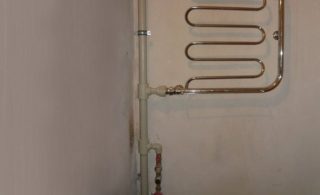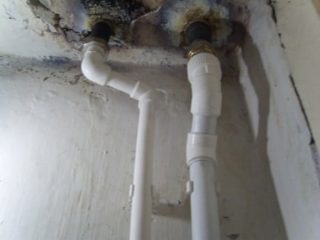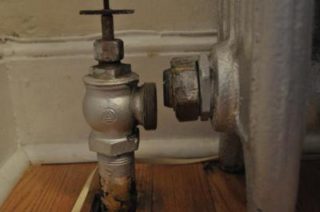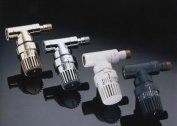To distribute the coolant flows in multi-storey buildings, vertically placed pipes are used, which have a characteristic name - a heating riser. They are laid by a through route on all floors of the building and in apartments, in each of which a branch is made for connecting radiator batteries. Given the fact that the service lives of such pipes rarely exceed 25-30 years, special attention is paid to their renewal. To do this, you need to know the design features of the riser along with its components. In addition, you will have to familiarize yourself with the issues of turning off and replacing heating pipes in the apartment.
Functional purpose
Before updating the riser structure, they first deal with its functional purpose, which consists in the following:
- distribution of the heat carrier (heated water flows) among consumers;
- its delivery to the heating zones in the apartment (batteries);
- balancing the hydraulic load.
The indicators of the functionality of a common riser for a house are directly related to the characteristics of the distribution of coolant in individual apartments.
In the entrances of typical urban houses, an average of 4 to 8 heating verticals is provided (in multi-room apartments, their number reaches 4 pieces). In most schemes used, the riser is used to deliver hot coolant and to drain cooled water masses. Such an organization of transportation is characteristic of a single-tube system containing a “return”. With two-pipe wiring, each of these functions is performed by a separate branch line, passing through the floor and ceiling of the apartment.
Hydraulic load balancing is necessary to equalize the pressure over the entire height of the riser structure. The need for this is due to the complexity of the distribution scheme of water flows, which has many knees and turns. It will be necessary to take this factor into account when independently connecting additional batteries produced during system overhaul, for example.
Material selection for vertical heating pipes
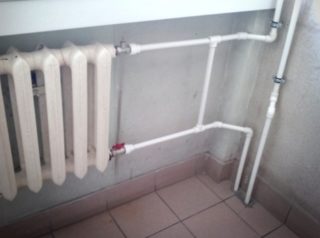
The riser heating system for residential buildings is an outdated scheme still found in most buildings of the last century. It was developed taking into account the layout of apartments, and its change after the end of the pipe service life is almost impossible. The only thing that is allowed to the owner in these conditions is to replace them by choosing a more modern and reliable material. Before buying tubular products, it is important to pay attention to their diameter, chosen equal to the same indicator at the bends.
The rest of the problems with the renewal of the pipes that have worked out their life are taking into account the conditions under which it is supposed to operate new products. They have to:
- withstand high temperatures of the coolant, as well as its sharp changes;
- Do not collapse under high pressure in the system and possible hydraulic shocks;
- allow the possibility of insulation in open areas of wiring (in multi-story private houses, for example).
Both traditional steel and modern polypropylene or metal-plastic pipes meet all these requirements. The user needs to choose the preferred option by comparing the characteristics of these products. It is important to consider the following features of the presented options, which are manifested when comparing them:
- polyethylene pipes are very convenient for installation and maintenance, and also have a relatively low price;
- they are not susceptible to corrosion and, unlike metal analogues, have long service life;
- cross-linked polyethylene (SP) pipes and their metal-plastic analogues are more durable and durable, but their cost is higher than that of other product samples.
Strong and corrosion-proof copper pipes have the highest heat transfer, but their significant disadvantage is their high cost. The disadvantages of metal-plastic products include low reliability of the connection in the case of using fittings. With significant pressure drops in these places, a leak may occur.
The best option is polypropylene pipes with a high strength index, marked as PN25. However, they can be used at temperatures not exceeding 90 degrees. If such conditions cannot be ensured, not very durable steel pipes should be selected.
DIY installation of a heating riser
Replacing heating in apartment buildings comes down to moving the pipes to a more suitable place with their full renewal. This is best done not in the heating season, when the house is disconnected from the thermal substation. Before changing them to new samples, you will need to solve the following issues:
- obtain permission from the heat supply organization (UK);
- prepare pipe blanks and a new wiring diagram.
In winter, the issue of replacement is additionally consistent with the residents of apartments connected to the riser.
Features of replacing and connecting radiators
When replacing the riser, at the same time, the heating elements (batteries) connected to it should be updated, being guided by a pre-drawn switching circuit. You will also need to prepare a complete set of equipment, without which radiators will not be able to effectively heat the room. Their binding includes the following elements:
- shutoff valves used for dosing the volumes of coolant in the batteries and their overlap;
- a temperature regulator, the main purpose of which is automatic stabilization of the temperature of the heat flow;
- traffic jam elimination mechanism (Mayevsky crane).
For a single-pipe system, a pipe segment is required that connects the inlet and outlet radiator pipes (bypass). Its diameter is taken a size smaller than that of the riser, and the length is selected taking into account what is the distance between the heating pipes. In the presence of a bypass, it is possible to prevent the appearance of zones of reduced pressure in the system.
As control equipment, it is allowed to install pressure and temperature sensors in the battery strapping. To prevent the formation of blockages, a coarse strainer is mounted in it. It is placed on the supply pipe - in the area in front of the thermostat.
Turn off the heating riser

Before replacing the riser from old pipes, you will have to disconnect it from the heat supply, which is associated with organizational and technical difficulties. The following preparatory procedures will be required to resolve this issue:
- submitting an application to the Criminal Code, responsible for the heat supply to the residential building;
- coordination with her representative of the timing of the replacement;
- discussion of the issue with the neighbors on the porch, which directly affects the disconnection of the riser from the heat supply.
The last point is the most difficult to implement, which once again confirms the validity of work in the summer. In this case, the coolant in the riser is partially or completely absent, and the ongoing repairs have no effect on neighboring apartments.
In any case, before upgrading the distribution system, you will have to perform the following steps:
- to obtain TU from the heat supply company with the parameters of the system components specified in them and the pipe wiring diagram;
- purchase all the necessary equipment, including pipe billets and batteries;
- coordinate the time of the heat supply shutdown with the cooperative or the council of residents.
The riser is updated independently or professional workers are invited to do so. The second option is more preferable when heating batteries are transferred at the same time as the replacement. If the scope of work is not too large, it is more convenient to negotiate with a local plumber. For a moderate fee, he will perform all preparatory operations, allowing you to immediately begin installation work.
It is enough for the owner of the apartment to agree on the time of their holding and invite the plumber immediately before the dismantling of the old riser. Tom will need to go down to the basement of the building and close the desired valve. After disconnecting the riser from the heat supply system, it will also help to discharge the remaining water mass in the pipes.
Water must be drained from vertically arranged pipes beforehand, since even after disconnecting from the substation, a small amount remains in the pipes. The height of the accumulated water column often reaches the highest floors of city buildings.
